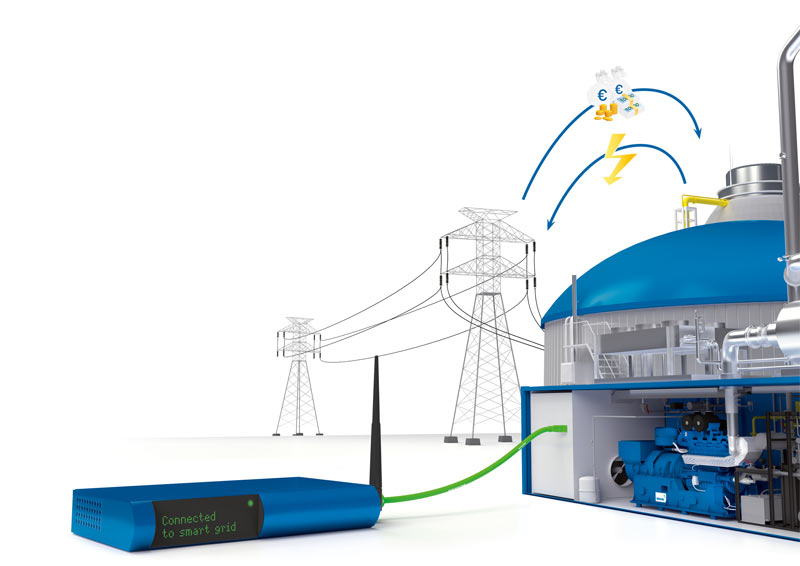Balancing energy
Utilizing opportunities in trading and electricity balancing markets
In light of the energy turnaround and greater decentralization, the energy market faces major challenges. A key factor is grid stability, which is safeguarded by the balancing energy market. The network frequency in the European grid is 50 Hertz. Fluctuations between feeding in and withdrawing electricity from the network are allowed in the range between 49.8 and 50.2 Hertz. In case levels overshoot or undershoot this range, the system must compensate for the frequency fluctuation – this is where the so-called balancing energy or operating reserve comes into play.

Virtual power plant inside a real container: Natural gas power plant Anderlingen-Ohrel, Germany: A containerized TCG 2016 V08C generates 3,200 MWh power and 2,552 MWh heat annually.
There are three quality categories available for balancing energy – primary, secondary and minute reserve (also referred to as tertiary reserve). These three types of output differ in terms of their speed of activation and adjustment. For instance, the primary operating reserve must be made available within 30 seconds, and the secondary operating reserve within 5 minutes. The minute reserve requires activation within 15 minutes.
In Germany, required balancing energy capacities are tendered online once per week (primary and secondary operating reserve) and once per day (minute reserve) by the transmission system operators (TSOs). All operating reserves are procured as positive and negative balancing energy. In case operating reserves are called up, the transmission system operator can boost (positive balancing energy) or lower (negative balancing energy) electricity production into the public grid.
Boosting earnings and profitability
“By means of virtual networking of several decentralized systems (virtual power plant) through a direct marketer, the participation in the balancing energy market becomes interesting also for operators of smaller plants, as the feed-in tariffs for the traditional feed into the grid are declining”, says Daniel Bach, Product Line Management.
The decisive argument for participation in the balancing energy market with a single power production unit is proof towards the network provider that the plant fulfills the pre-qualification for balancing energy. To do so, relevant data such as rated output, (net) maximum and minimum output, voltage level and balancing group allocation are transmitted to the TSO. In case of a virtual power plant, each system must meet the requirements. In addition, the provider must be licensed with the European Energy Exchange (EEX).
Increased requirements
All marketing platforms for balancing energy require a flexible CHP plant operation. This creates new requirements, e.g. extremely short and defined ramp-up and ramp-down times and the capability of steep load ramps. Contrary to these requirements, gas engines in the upper output range are typically designed for stationary operation and are of limited suitability for dynamic deployment due to their inertia. Through continuous development at MWM and adaptations in the controller software, the flexible mode of operation is being steadily expanded to ensure our gensets meet changing requirements. The MWM TCG 2016, TCG 2020 and TCG 2032 gas engines are suitable for the generation of balancing energy. This can be achieved in two different modes of operation:
- Provision of balancing energy in the partial-load range
- Cold start (full genset output is used)
To ensure optimum cost effectiveness during operation of the plant, both modes of operation can also be combined. Operation in partial-load range, the preferential method these days, is recommended, as operation in partial-load range means considerably less wear than in start-and-stop mode.

Both secondary and tertiary reserves can be generated by the TCG 2016 and TCG 2020 series.
When operating the system in partial-load range, MWM gensets can generate all three types of operating reserve. Cold-starting the system for balancing energy operation is only useful and possible without technical modifications if:
- up to 4 starts occur per day (or max. 1,000 starts per year)
- the minimum running time of a genset after start-up is 2 hours
Both secondary and tertiary reserves can be generated by the TCG 2016 and TCG 2020 series (cold starts). The TCG 2032 series can be used for tertiary reserves.
Adjust maintenance to operations
Frequent cold starts result in higher wear and shorter maintenance intervals, which means that project-specific adjustments are necessary. In this mode of operation, the gensets from MWM are capable of generating secondary and minute reserves, but operation in partial-load range is considerably more component-friendly on the engine. An adjustment of the maintenance intervals, however, should always be reviewed, and increased wear should also be taken into account.During dimensioning, not only the engines should be considered, the other plant components must also be adapted to operating reserve mode. In the case of biogas, e.g. the gas storage units that enable a decoupling from gas production and gas consumption, or additional pre-heating systems, in order to ensure an adequate service life of the gensets. In an ideal scenario, the system is designed for this mode of operation from the beginning, and properly configured during commissioning routines. In case of engine replacement, the existing plant layout needs to be reviewed for suitability for this mode of operation.

Virtual power plant: A decentralized MWM power plant is connected to a direct marketer via a communication box (Smart Grid).
Under these circumstances, all series from MWM having a power range from 400 to 4,300 kWel can be utilized for providing balancing energy. Despite declining or expiring subsidies granted by the German Renewable Energy Sources Act, the provision of balancing energy can make operations economically attractive or even yield significant additional revenues. The gensets fulfill the relevant technical requirements and the practical criteria of third-party providers for pooling (marketing via a virtual power plant).
Photos: Caterpillar Energy Solutions GmbH






































